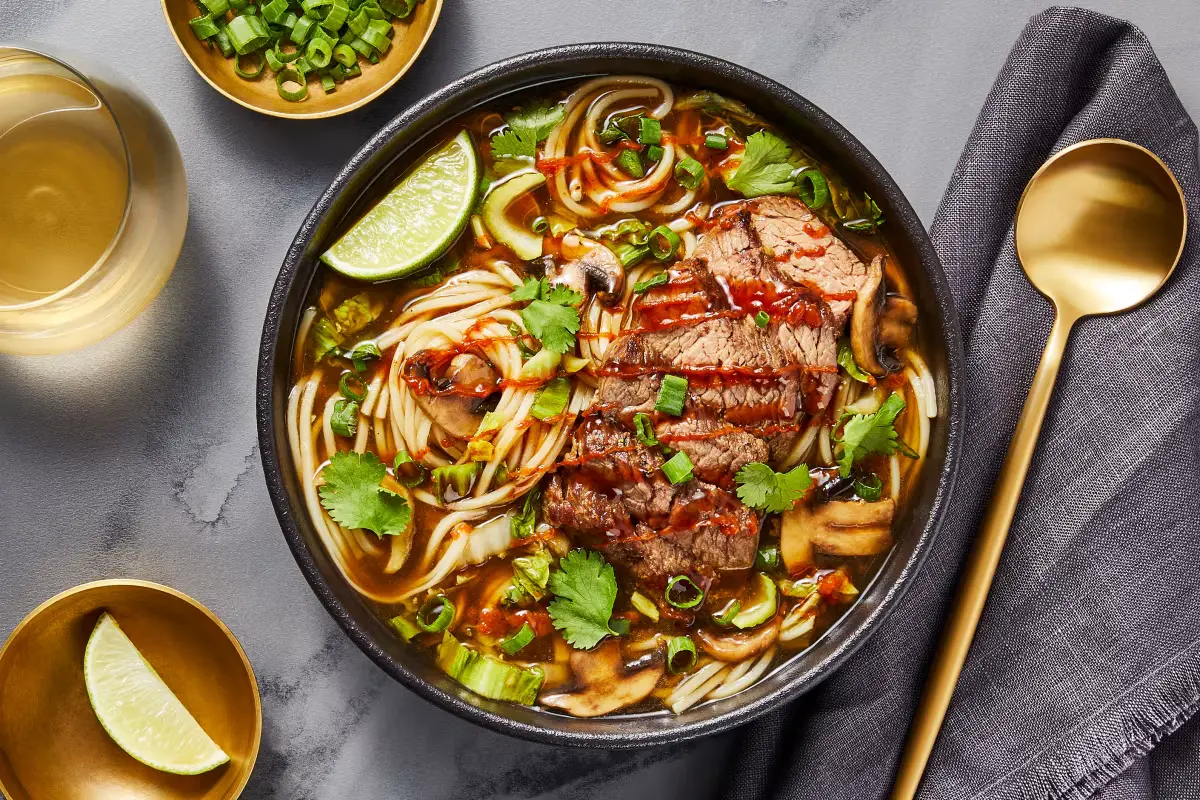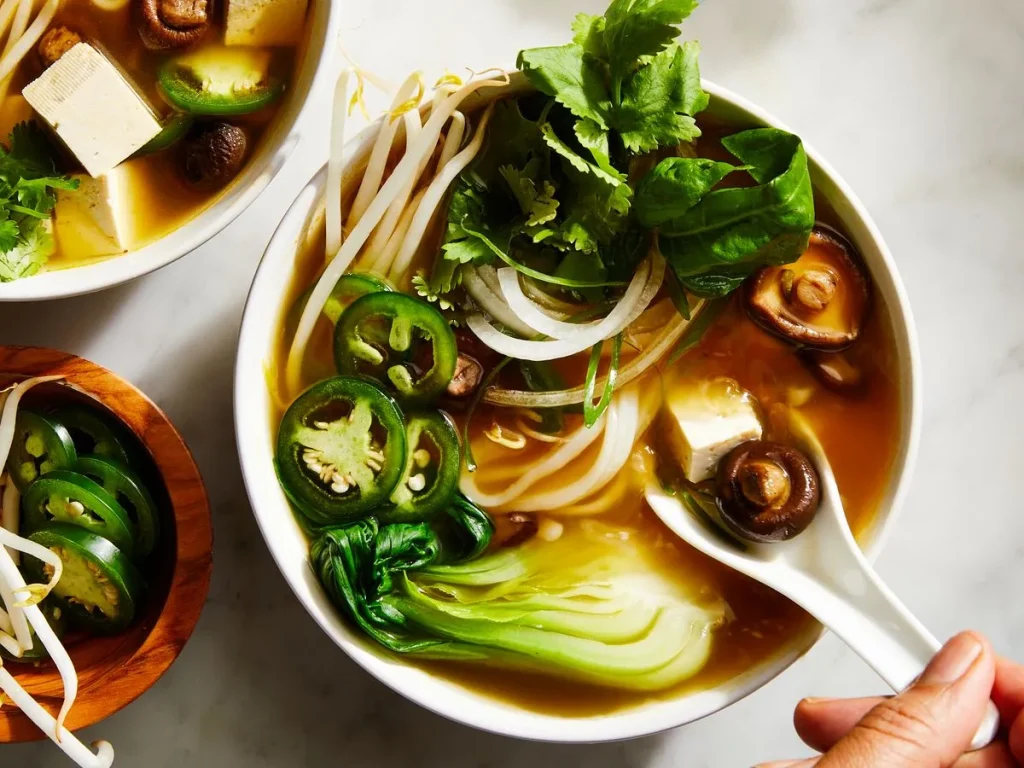Pho Perfection: Savor the Soulful Flavors of Vietnam’s Beloved Noodle Soup

A symphony of flavors and textures, pho is not only Vietnam’s most famed culinary export but also a warm, soothing bowl that summarizes the soul of Vietnamese cuisine. Eminent noodle soup, distinguished by a transparent, fragrant, broth, soft meats, and fresh herbs, pho is treasured globally for its distinct taste experience, which both comforts the spirit and titillates the tastebuds. In this thorough adventure, we discover the brief history, cultural relevance, and gastronomic mysteries of pho, and lead you through the process of eating and admiring this iconic Vietnam meal.
Table of Contents
ToggleThe Origins of Pho
Historical Roots
Pho’s story started in the early 20th century in Northern Vietnam, mostly around the capital Hanoi . The dish grew out of local soups developed over centuries and the French culinary tradition brought by colonizers. From being a straightforward peasant meal, Pho began adopting more sophisticated tastes and cooking techniques until it became prominent all over Vietnam.
Cultural Journey
As Vietnamese people migrated, they took their beloved Pho with them, introducing it to a global audience. Today, Pho is not only a staple in Vietnamese restaurants worldwide but also a representation of Vietnamese culture and culinary prowess on the international stage.

Crafting the Perfect Bowl of Pho
Essential Ingredients
Most importantly in Pho, the soul is always located in the broth, which is composed of beef bones boiled with spices such as star anise, cinnamon, cloves, and cardamom for many hours together . Such depth of flavor and fragrance is distinguished by a genuinely delicious soup. Rice noodles are the quintessential barely-there carbohydrate, which serves as a slippery base for the soup.
The Role of Meats and Garnishes
Thinly sliced beef, known as Pho bo or chicken, Pho ga, are the traditional choices used in serving the food thus cooked gently so that they attain tenderness. Consuming pho also involves adding insult, which may entail seeding the bowl and adding basil, lime, bean sprouts, and sliced jalapenos for a contrasting color and crunchy texture.
The Art of Eating Pho
Culinary Rituals
Eating Pho is almost a ritualistic experience. The perfect spoonful combines broth, noodles, meat, and herbs in just the right proportions. Diners are encouraged to slurp the noodles—a sign of enjoying the meal in Vietnamese culture—and to experiment with condiments like hoisin sauce and Sriracha to personalize their dish.
Sensory Experience
This is an amazing experience for all the user’s senses: the sight of the steam emanating from the hot broth, the smell of the aromas, the sound of slurping, and the rich flavors and assorted textures that explode upon the mouth. That is why Pho is not only food, but a full sensory experience is truly deserving.
Pho Across the Globe
Adaptations and innovations
As Pho traveled around the world, each culture even influenced its taste and ingredients. In some countries, you may find versions with other meats such as duck or seafood or vegetarian broth without meat. However, whether, in Poland or in Japan, pho still pho but with local spices.
Pho as a comfort food
Pho is recognizable in terms of comfort food because its warm broth warms you on cold days, and the richness of spices enriches the taste and fills the stomach at any time. Pho inspires a multitude of flavors that extend its mission to comfort food, which helps it gain dedicated fan groups all over the world.
Making Pho at Home
Cooking Tips
Making Pho at home can be a rewarding experience, although it requires patience and attention to detail. The key is in the broth; it must simmer for several hours to develop the correct depth of flavor. Home cooks should source the best quality spices and bones they can find and consider using a spice bag for easy removal.
Ingredients and Where to Find Them
Most ingredients for Pho are readily available in Asian supermarkets. Fresh spices, rice noodles, and beef cuts commonly used for Pho are essential. For authenticity, seek out Vietnamese herbs like Thai basil and sawtooth herb, which might be found in specialty stores.
Celebrating Diversity through Regional Variations of Pho
Northern vs. Southern Pho
Pho is a widely varied dish that is representative of the diversity inherent in Vietnam. Northern Pho, and particularly that of Hanoi, often have a stockier and less opaque broth that places high value on individual flavor retention. Southern Pho, typically ordered in Ho Chi Minh City, has a higher level of sweetness and overtness and complexity due to the addition of many more herbs, assertions, and condiments. Compiling these distinctions expands the experience of Pho by allowing one to compare and contrast how the neighboring Pho expands the more general culinary spirit of Vietnam.
The Expanding Palette of Pho Flavors
As Pho continues to evolve, chefs both within and outside of Vietnam experiment with ingredients that reflect local tastes and seasonal availability. This might include the addition of local seafood in coastal areas or the use of unique spice blends in different countries, creating a global tapestry of Pho flavors that continues to grow and inspire.
Pho in Culinary Education
Cooking Classes and Culinary Tours
In addition to its prominence as a menu item, Pho has increasingly served as a common theme in cooking classes and culinary tours for foodies interested in mastering the do braising and challenging job of making Vietnamese pho. The dishes on this aspect of learning involve the anthropology making a flavorful soup with a diversified spice flora, as well as the proper arrangement of the pho bowl. Traveling to Vietnam to understand the critical english vocabulary word market and developing a meal on their own is the biggest factor in the finding is getting as a dining experience.
Pho’s Role in Culinary Schools
Given the growing interest in Asian cuisines, Pho is increasingly included in the curriculum of culinary schools around the world. As a result, students master traditional Vietnamese methods of cooking, sourcing products, and the meaning of ultimate dishes such as Pho. Such learning is instrumental in developing in chefs an understanding and respect for world cuisines so that later they could safely apply this knowledge to create good experimental cross-cultural fusions on wdbos.

The Health Benefits of Pho
Nutritional Value
Pho is celebrated not only for its taste but also for its nutritional value. The broth, rich in collagen and minerals from the slow-cooked bones, is excellent for bone and joint health. Lean cuts of meat provide protein, while the assortment of herbs offers vitamins and antioxidants that promote overall health and well-being.
Dietary Adaptations
For those with dietary restrictions, Pho can be easily adapted. Bone broth can be substituted with vegetable broth for a vegetarian or vegan version, and gluten-free rice noodles are an excellent option for those avoiding gluten. The versatility of Pho makes it accessible and enjoyable for people with various dietary needs.
Pho as a Cultural Ambassador
Pho Festivals and Competitions
Around the world, Pho festivals and cooking competitions celebrate the dish’s cultural heritage and culinary importance. These events serve as platforms for both amateur and professional chefs to showcase their skills and interpretations of Pho, further enriching the global food scene.
Documentary and Media Features
Pho has been the subject of various documentaries and media features that explore its origins, its impact on Vietnamese culture, and its global spread. These stories highlight Pho’s role in discussions about immigration, globalization, and culinary exchange, emphasizing the dish’s broader cultural significance beyond its ingredients.
A Bowl Full of Stories
Pho embodies more than just a noodle soup carryall; it emulates a journey through time, culture, and people. Every bowl signifies a story of roots, re-innovations, and all humans gathering around something great to eat. Pho, as it tantalizes taste buds all around the globe, it does more than just filling bellies, it links worlds and confirms that the pleasure for good food is indeed the one language each person speaks. That impression may be experienced in Vietnam’s core while taking a warm bowl of soup, or about the corner at home.
With each taste of Vietnamese heritage, you will feel engrossed and ultimately content. A humble meal in the human-writing covers of simple food ethics and multicultural resemblances. From its slender Vietnamese origin to an exceptionally globalized international adventure, nothing describes the magnetic quality of admired cuisine than flavorful work that can be loved anywhere. Whether willingly gulped in a local cafeteria or loved in a bowl in a bustling region, the Pho remains recognized and rejoiced in. In every bowl see the flavor and recognize the rich history and culture captured in its brothy confines.
Also read: Bubur Pedas: Petualangan Pedas Melalui Masakan Asia Tenggara 2024



